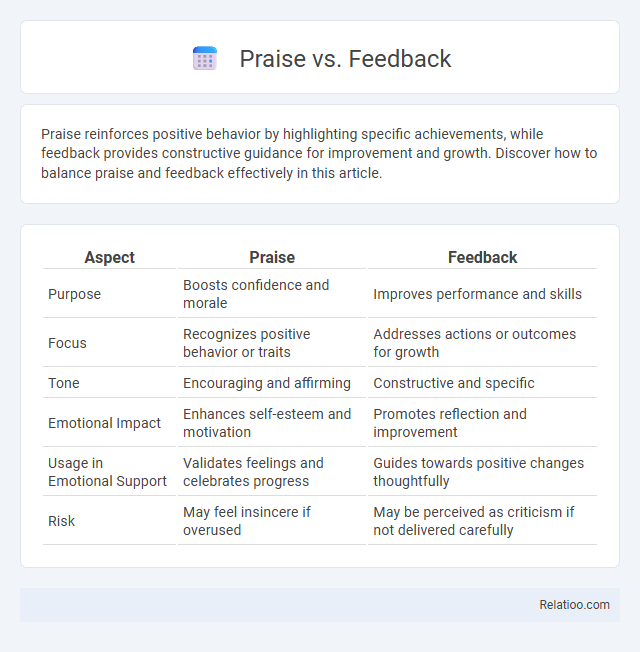Praise reinforces positive behavior by highlighting specific achievements, while feedback provides constructive guidance for improvement and growth. Discover how to balance praise and feedback effectively in this article.
Table of Comparison
| Aspect | Praise | Feedback |
|---|---|---|
| Purpose | Boosts confidence and morale | Improves performance and skills |
| Focus | Recognizes positive behavior or traits | Addresses actions or outcomes for growth |
| Tone | Encouraging and affirming | Constructive and specific |
| Emotional Impact | Enhances self-esteem and motivation | Promotes reflection and improvement |
| Usage in Emotional Support | Validates feelings and celebrates progress | Guides towards positive changes thoughtfully |
| Risk | May feel insincere if overused | May be perceived as criticism if not delivered carefully |
Understanding Praise and Feedback
Understanding praise involves recognizing positive reinforcement that boosts motivation and confidence by highlighting specific achievements. Feedback, by contrast, provides constructive insights aimed at improvement and skill development, offering detailed observations and actionable suggestions. Your ability to differentiate between praise and feedback ensures balanced communication that fosters growth while maintaining encouragement.
Key Differences Between Praise and Feedback
Praise highlights specific achievements and reinforces positive behavior by expressing approval, fostering motivation and self-esteem. Feedback provides constructive information on performance, emphasizing areas for improvement and actionable guidance to enhance skills and outcomes. Unlike praise, which centers on encouragement, feedback aims at development through honest, objective evaluation.
The Role of Praise in Motivation
Praise plays a crucial role in motivation by reinforcing positive behavior and boosting self-esteem, which encourages individuals to maintain or improve their performance. Unlike feedback, which provides specific guidance for growth, praise focuses on recognizing achievements and effort, fostering a sense of accomplishment and intrinsic motivation. Your ability to deliver meaningful praise can significantly impact motivation levels, leading to sustained engagement and improved outcomes.
How Feedback Drives Improvement
Feedback drives improvement by providing specific, actionable information that highlights areas for growth and development, unlike praise which often centers on general approval. Constructive feedback targets performance gaps and encourages reflection, enabling individuals to adjust strategies and enhance skills effectively. While praise boosts motivation and confidence, feedback fosters continuous learning and measurable progress in personal or professional settings.
When to Use Praise vs. Feedback
Praise is most effective when recognizing specific achievements or positive behaviors to boost motivation and self-esteem. Feedback should be used to provide constructive guidance aimed at improving skills, performance, or processes, especially when learning or development is the goal. Use praise to reinforce what is done well, and feedback to address areas needing improvement for continuous growth.
The Impact on Workplace Culture
Praise fosters motivation and reinforces positive behaviors, creating an uplifting workplace culture that encourages employee engagement. Constructive feedback drives continuous improvement and skill development, promoting a culture of learning and accountability. Balancing praise and feedback cultivates trust and transparency, essential for a collaborative and innovative organizational environment.
Common Mistakes in Delivering Praise and Feedback
Common mistakes in delivering praise and feedback include providing vague or generic comments that lack specific examples, which diminishes their impact and fails to guide improvement. Overusing praise can lead to complacency, while delivering feedback without balancing positive recognition may cause defensiveness or demotivation. You should aim for clear, constructive, and targeted communication to foster growth and maintain motivation effectively.
Best Practices for Effective Praise
Effective praise focuses on specific behaviors and genuine recognition, reinforcing positive actions that motivate continued improvement. Your praise should be timely, sincere, and directly linked to achievements or efforts, avoiding generic or inflated compliments that can undermine credibility. Balancing praise with constructive feedback ensures clarity, fosters growth, and maintains trust while promoting a positive and productive environment.
Best Practices for Constructive Feedback
Constructive feedback involves specific, behavior-focused comments that guide improvement while maintaining respect and encouragement. Unlike praise, which highlights strengths and achievements, constructive feedback targets areas for growth with actionable suggestions. Best practices include balancing positive reinforcement with clear, objective observations to foster development and motivation effectively.
Balancing Praise and Feedback for Growth
Balancing praise and feedback is essential for fostering growth and motivation in individuals, as praise reinforces positive behaviors while feedback identifies areas for improvement. Constructive feedback should be specific, actionable, and delivered alongside genuine praise to create an environment that encourages continuous learning and self-reflection. Effective leaders and educators prioritize this balance to enhance performance, build confidence, and drive sustainable development.

Infographic: Praise vs Feedback
 relatioo.com
relatioo.com